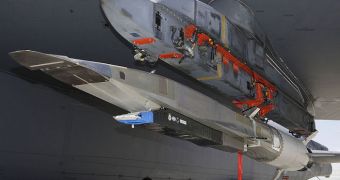The US Air Force has over the past few years been developing a new type of airplane, a scramjet-powered hypersonic craft, capable of reaching as much as Mach 7 in speed. Experts in charge of the project have already flown the X-51 Waverider while attached to a B-52 bomber, and they recently announced that they were about to begin the first of four test flights to see the X-51 actually separating from its host, and going hypersonic. The goal engineers tried to achieve was to create a plane that would travel faster and further than all of its predecessors, Space reports.
St. Louis-based Boeing Defense, Space & Security Systems has been working on the airplane since 2003, and officials here highlight the fact that the new airplane is the first hypersonic vehicle to fly in the United States for the past six years. Behind this project are the Air Force Research Laboratory and also the mysterious Defense Advanced Research Projects Agency (DARPA). The second organization had a lot to do with many of the objects in the modern world that we see and touch every day, such as the Internet and the computer mouse, but its name is barely ever mentioned in association with these accomplishments. It is heavily involved with classified research projects.
The unmanned X-51, which is shaped like a missile, will be flown to its designated released altitude on another B-52 bomber, Boeing's director of hypersonics, Joe Vogel, announced on February 22. This type of flight is widely accepted as beginning at Mach 5, as opposed to the start of supersonic flight, at Mach 1. The reason why Mach 5 is considered to be a threshold by many is the fact that a combination of phenomena, including the molecular dissociation and ionization of the airflow around the plane, starts to play a very significant part in the overall forces that particular craft is subjected to. Coming up with a more rigid definition for when hypersonic flight begins is rather difficult, because many characteristics change at different speeds, not all at once.
During the Waverider's maiden flight, the rocket-shaped aircraft will be dropped from its carrier over the Pacific Ocean, where it will fall freely for 4 seconds. Afterwards, its massive motor will spring to life, and quickly accelerate it to a speed of about 5,800 kilometers per hour, near the Mach 5 horizon. Once this speed is reached, the scramjet outfitted on it will roar to life, and will accelerate the craft even further, to Mach 6, or about 7,400 kilometers per hour. Canoga Park, California-based Pratt & Whitney Rocketdyne is the main contractor on the motor that will deliver the final kick.

 14 DAY TRIAL //
14 DAY TRIAL //